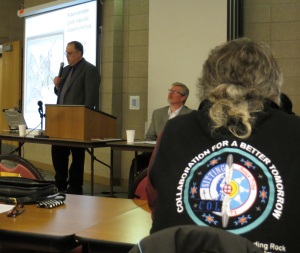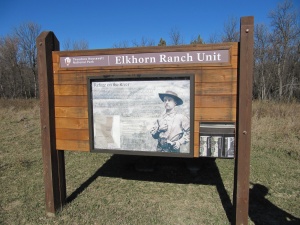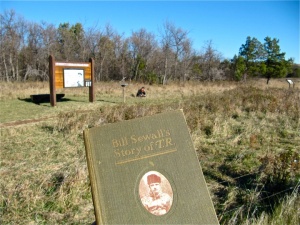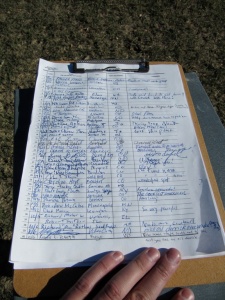Okay, next crisis. There seems to be one every day for people like us who are concerned about the impact the oil industry is having on western North Dakota. Negative impact, that is. There are lots of positive impacts. I take note of those, and am grateful, like every other North Dakotan. It’s the negative impacts I worry about, and write about here.
Late last year, you read in the papers and saw on TV the stories about the North Dakota Industrial Commission, which is the three state officials who approve permits to drill for oil in North Dakota, granting permission for oil companies to drill for oil in Little Missouri State Park. A few people raised a ruckus, but the drilling is proceeding.
Earlier this year, you read about a group of Dunn County citizens who were concerned about the Industrial Commission
granting a permit to drill for oil in the Killdeer Mountains. The citizens attended the Industrial Commission hearing and had their say. Their say was, “this is a bad place to drill for oil.” The Industrial Commission thanked them for their input and said they would take the permit application under advisement and make a decision sometime in the future. The Dunn County citizens got in their cars and headed home for supper. Before they had gotten past new Salem, the Industrial Commission brought the matter back up and voted to approve the permit. The Dunn County citizens read about it in the paper the next morning. Everyone I talked to the next day agreed it was one of the most chickenshit things state officials in North Dakota had done in a long, long time, maybe ever. For the record, the three men who did that are named Jack Dalrymple, Wayne Stenehjem and Douglas Goehring.
Well, there’s going to be another Industrial Commission hearing on Thursday, March 28, at 9 a.m., at the North Dakota Capitol, at which time they are going to be asked for a drilling permit for another really bad place to drill for oil. This time, it is right beside the Elkhorn Ranch Unit of Theodore Roosevelt National Park. And I mean RIGHT BESIDE. I mean, when you drive your car down the gravel road into the Elkhorn Ranch, and pull into the little parking lot, and up to the gate to the walking trail down to Theodore Roosevelt’s cabin site, and get out of your car, there’s going to be an oil well beside the passenger side door of your car. RIGHT THERE. If the Industrial Commission grants the permit. No kidding.
If you look at the

docket for the hearing on March 28, you’ll find, buried way down near the end, on page 22 of a 24 page document, Case No. 19996. It reads
“Application of XTO Energy Inc. for an order authorizing the drilling, completing and producing of a total of four wells on an existing 1280-acre spacing unit described as Sections 5 and 6, T. 143 N., R. 102W., Morgan Draw-Bakken Pool, Billing County, ND . . .”
Luckily for us, someone actually reads all 24 pages of these dockets, looking for danger signals like this one. In this case, that someone happened to be an employee of the National Park Service, who thought to himself or herself, I don’t know which, “Hmmm, that description looks familiar. I know where that’s at.” The National Park Service is the federal agency which manages Theodore Roosevelt’s Elkhorn cabin site. Which just happens to be located in . . .you guessed it . . . Section 5, T. 143N., R. 102W, Billings County, ND.
That sharp-eyed employee, in a recent visit to the Elkhorn Ranch site, discovered that, long before the Industrial Commission has made its decision on whether or not to approve the drilling permit, XTO Energy has already been to the site and put stakes in the ground for a proposed oil well on U.S. Forest Service land directly adjacent to the Elkhorn Ranch, very close to the small parking lot.
I’m attaching a map to this story which shows the location of the Elkhorn

Ranch. The two sections being discussed for drilling by XTO are outlined by me in red. The sections shaded green on this map are owned by the U.S. Forest Service. Purple is National Park Service. Blue is the North Dakota Parks and Recreation Department. White is privately owned land. As you can see, the U.S. Forest Service owns almost all of Sections 5 and 6, except for just a little bit of the upper right hand corner of the section. XTO holds the mineral leases on those two sections, for which they paid a good deal of money. Now they’ve decided it is time to get their money back—and then some—by drilling four oil wells there. The Elkhorn Ranch site, which is only 70 or 80 acres, actually has little pieces of four different sections. The little piece in section 5 is where the parking lot is. If you look carefully, you can see the red-dotted line coming in from the west right up to the edge of the purple. That’s the gravel road to the parking lot. I haven’t been out there yet to see the stakes, but the Park Service employee says they are right there by that road, right close to the parking lot.
If you’ve ever driven in on that road to the Elkhorn site, you know that sections 5 and 6, through which the road passes, are very rugged, full of hills and gullies. Real Bad Lands. But just before you get to the Elkhorn site, you come down a big hill and there’s a nice flat area as you approach the parking lot, probably 30 or 40 acres. Just big enough for a pad holding four oil wells, a bunch of tanks and all the other apparatus that goes with an oil well site. There are not many other places in those two sections –in fact, I don’t think there are any—that would be suitable for an oil well pad. I’m going to go out there and look for myself next week.
The Maah Daah Hey Trail, one of the most famous hiking and bicycling trails in America, also runs throughout the length of these two sections, so I would guess the Forest Service would be concerned about the well site as well. It’s the borken red line running through the two sections.
In fact, a friend of mine at the Park Service said the two agencies have talked about this, and the Forest Service says not to get too excited because nothing has been approved yet. Huh. Never mind that the stakes are in the ground for a well site. And with the permit application moving forward, it is obvious XTO is going to drill somewhere in those two sections, IMMEDIATELY ADJACENT TO THE ELKHORN RANCH. If the Industrial Commission gives them a permit. IF.
There’s another interesting angle at work here as well. The North Dakota Parks Department manages the land on the North and South sides of the Elkhorn. One would think that agency would be concerned about this, and be talking to the boss over in the Capitol about it. Seems to me the Industrial Commission would surely want to know how the state’s own Parks Department feels about this. At least in most states they would.
This isn’t the only threat to the Elkhorn, of course. You’ve already read here about the proposed
gravel pit just across the river, and the proposed
bridge cross the Little Missouriright beside the Elkhorn. From what I can tell, the preferred location for the bridge would be about 500 yards from where the stakes for the new oil well are. Well, isn’t that conveeeeeeenient, as the Church Lady used to say.
This is not just a North Dakota issue. National organizations like the Theodore Roosevelt Association and the Boone and Crocket Club have been involved in the resistance effort on the gravel pit and the bridge. I hope they will get involved on this one as well.
My friends in the Park Service are using words like “imminent threat ” and “extremely serious.” Rightfully so. Four oil wells this close to one of the nation’s most revered conservation spots is pretty much unthinkable. Anywhere but North Dakota. Here, they’re thinking about it.
Please put the date on your calendar. Please come and let your state officials know this is a really bad idea. But don’t leave early.








